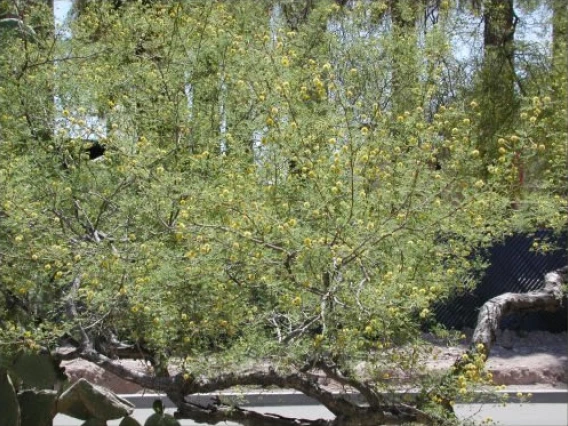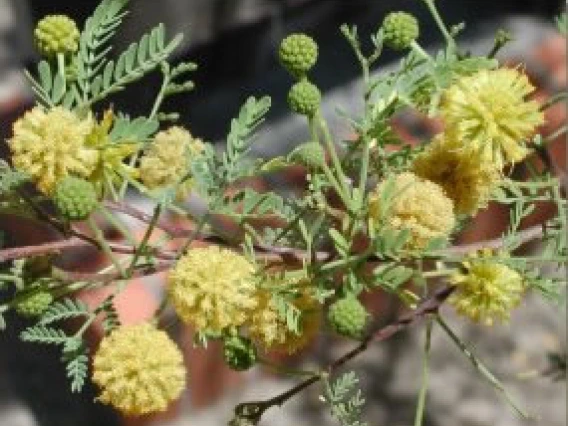


Common names:
- English: White-Thorn Acacia
- Spanish: Huizache
- O’odham: Giidag
Family Name: Fabaceae | Synonym: Leguminosae
Botanical Name: Acacia constricta
Rain Garden Zone: A. constricta thrives in the terrace rain garden zone; however, it can grow well in the bottom rain garden zone provided the trunk is not exposed to prolonged standing water. The bottom zone is typically the bottom of a basin or swale. This location is prone to temporary pooling of water as well as nighttime cool air pockets. The terrace zone is typically atop a terrace or on the bank of a basin or swale. These sites have more shallow, less-frequent, and more temporary pooling than in bottom zone.

Reproduced with permission from "Rainwater Harvesting for Drylands and Beyond" by Brad Lancaster, HarvestingRainwater.com
Flowering Season: March - May
Harvest Season for Mature Pods: Late summer, and early fall
Planting Season: Monsoon
Landscape Cultivation: Most species of Acacia require acid scarification for germination to occur between 7 and 12 days. A 30 minute soak in concentrated sulfuric acid should permeate the seed coat. Without scarification, germination may take up to 30 days or longer.
Characteristics: White-thorn acacia is considered a large shrub or small tree, reaching a height of 6 meters. The leaves are alternate and bi-pinnately compound. Flowers are dense and bright yellow, attached at the leaf axils. The fruit of A. constricta are straight or strongly curved legumes, which have a red-brown color and papery texture.
Ecological Benefit: Bees, butterflies, and other insects feed on the nectar of the white-thorn acacia's flowers. Granivorous birds and small mammals feed on the seeds.
Practical Uses:
- Food - The pods of the white-thorn acacia can be dried and ground into a flour.
- Domestic Animals - Cattle and deer may browse both the leaves and pods of the white-thorn acacia. Honeybees are attracted to the bright-yellow, fragrant flowers and produce honey from its nectar.
- Other - White-thorn acacia has traditionally been used for its medicinal properties. Mashed seeds can be made into a tea to relieve upset stomachs. Additionally, dried pods can be powdered and used topically to treat skin rashes.
References:
- Desert Harvesters. (2018). Eat mesquite and more: a cookbook for Sonoran desert foods and living. Tucson, AZ. RainSource Press.
- Hodgson, W. C. (2001). Food plants of the Sonoran desert. Tucson, AZ. University of Arizona Press.
- Lancaster, B. (2019) Rainwater harvesting for drylands and beyond, 3rd edition. Tucson, AZ. RainSource Press.
- Little, E. L. (1980). The Audubon Society field guide to North American trees, western region. Alfred A. Knopf.
- Rea, Amadeo M. (1997). At The Desert's Green Edge - An Ethnobotany of the Gila River Pima. Tucson, AZ. University of Arizona Press.
For more information on this plant, see the Campus Arboretum species description pages.
Go to the next tour stop: staghorn cholla page or Return to the main Dunbar Spring tour page

